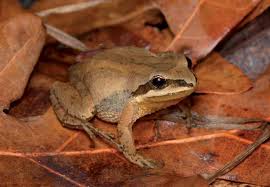By Alex Sloane, Water Quality and Education Associate
The NJ Department of Environmental Protection is amending the conservation status of the New Jersey Chorus Frog (Pseudacris kalmi) from undetermined (U) to special concern (SC). Undetermined status is given to a species about which there is not enough data to make a conservation status determination, while a species of special concern is a species with “evidence of decline, inherent vulnerability to environmental deterioration, or habitat modification that would result in their becoming a threatened species” (dep.nj.gov – Species Status Assessment).


Amphibians are sometimes known as indicator species because they are very sensitive to environmental changes such as habitat loss, pollution, and degraded water quality. This can give early warning signs to scientists that something in the environment has changed before larger scale impacts or symptoms can be seen. Additionally, amphibians are often both predators and prey, meaning population impacts will affect many other species as well. The New Jersey Chorus Frog was recommended a special concern status in 2016 due to habitat loss, but no formal rule proposal had been filed until now.
The New Jersey Chorus Frog is brown to gray in color and about ¾-1 ½ inches in size with a light strip along the upper lip and a dark stripe through the eye and down the side of the body. They are found in various wet habitats, including floodplains and wet woodlands containing shallow wetlands such as marshes, ditches, swamps, or vernal pools. This means that GSWA’s Conservation Management Area is the perfect place to find this species! Their breeding season begins in late winter, continuing all the way through June. Listen for a regularly repeating, creaking call – like someone running their nails along the teeth of a comb. Eggs may be seen attached to submerged vegetation in shallow bodies of water, and larvae reach the adult stage within about two months, usually in late spring.
We are pleased to know the NJ chorus frog is getting the attention and conservation status needed to protect their populations. They are an important part of our woodland and floodplain communities and an increased focus on their conservation will have rippling impacts on the rest of those natural communities. Learn more about the New Jersey Chorus Frog HERE.
